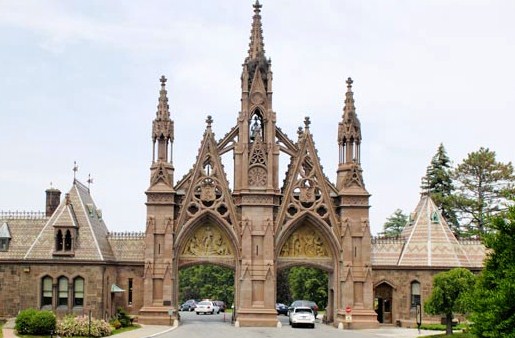The Brooklyn Bridge is one of New York City’s most iconic landmarks, but behind its steel cables and stone towers lies a history of struggle, sacrifice, and resilience. Thousands of immigrant laborers, particularly Irish and German workers, played a crucial role in constructing this engineering marvel. Many of these men risked their lives for low wages, leaving behind few records—making it challenging for their descendants to trace their stories. If your ancestor lived in Brooklyn or Manhattan during the late 19th century and worked in construction, there’s a chance they were involved in this monumental project.
This article will explore the role of immigrant laborers in building the Brooklyn Bridge, the dangers they faced, and how you can research family members who may have contributed to its construction.

The Brooklyn Bridge and Its Immigrant Workforce
Construction of the Brooklyn Bridge began in 1869 and lasted until 1883. The bridge, designed by John A. Roebling and completed by his son, Washington Roebling, connected the growing city of Brooklyn to Manhattan, transforming commerce and daily life. However, its completion would not have been possible without the thousands of immigrant laborers—many of whom had arrived in New York seeking a better life after fleeing poverty, famine, and political unrest in Europe.
Irish Workers: Escaping Famine, Facing New Hardships
Many of the bridge’s laborers were Irish immigrants, often recent arrivals who had fled the devastation of the Great Famine (1845-1852). By the time bridge construction began, Irish communities were well established in Brooklyn neighborhoods like Vinegar Hill, Five Points, and the Navy Yard district. Many Irishmen took on backbreaking jobs as sandhogs—workers who excavated the bridge’s massive foundations deep beneath the East River.
Sandhogs faced extreme danger, working in high-pressure caissons—large, airtight chambers sunk into the riverbed to allow for underwater excavation. These men endured unbearable heat, poor air quality, and the constant threat of explosions, fires, or deadly “caisson disease” (now known as decompression sickness). Many Irish laborers never made it home from the job site, but few official records documented their deaths.
German Laborers: Skilled Craftsmen and Engineers
The German community in New York, particularly in neighborhoods like Williamsburg and Bushwick, also contributed significantly to the Brooklyn Bridge. Many German immigrants arrived in the mid-19th century with specialized skills in ironworking, masonry, and engineering. Some worked as blacksmiths forging the bridge’s massive steel cables, while others were stonecutters shaping the granite blocks of the bridge’s towers.
German workers were also more likely to hold supervisory roles or work in skilled trades compared to their Irish counterparts, who often performed the most dangerous manual labor. If your ancestor was a German immigrant in Brooklyn during this period, their occupation might provide clues about their role in the bridge’s construction.
The Dangers of Building the Brooklyn Bridge
The Brooklyn Bridge claimed the lives of at least 30 workers, though the actual number may be much higher. Caisson disease, falling accidents, and explosions were all common hazards. Many deaths went unreported, particularly for immigrant laborers with no family in the city.
If your ancestor worked in construction and died suddenly between 1869 and 1883, it’s worth investigating whether they were involved in the bridge’s construction. Death records, newspapers, and labor union records may provide more information.
How to Research an Ancestor Who Worked on the Brooklyn Bridge
If you suspect an ancestor helped build the Brooklyn Bridge, here are some research steps to take:
1. Check Census Records (1870 & 1880)
Look for ancestors in Brooklyn or Manhattan who listed their occupation as laborer, mason, blacksmith, ironworker, or stonecutter.
Irish and German workers often lived in tenement housing near the bridge’s construction site.
2. Search Death Certificates (1869-1883)
If an ancestor died suddenly during this period, check New York City death records for cause of death (e.g., “accident,” “drowned,” or “caisson disease”).
Many Irish workers were buried in Calvary Cemetery in Queens, while German workers were often buried in Lutheran Cemetery (now All Faiths Cemetery) in Middle Village.
3. Review Newspaper Archives
The Brooklyn Daily Eagle and New York Times frequently reported on construction accidents. Searching archives for your ancestor’s name could yield valuable clues.
4. Look for Labor Union Records
Skilled German workers may have been members of trade unions. The International Association of Bridge Workers and the United Brotherhood of Carpenters are worth checking.
5. Explore Church Records
Many Irish workers attended Catholic churches like St. James Cathedral in Brooklyn, while German workers were often Lutheran. Baptismal and marriage records may provide insights into their lives.
Conclusion
The Brooklyn Bridge stands as a testament to the labor and sacrifice of New York City’s immigrant workers. If your ancestor was an Irish or German immigrant in Brooklyn or Manhattan during the 1870s and worked in construction, they may have played a role in building this iconic structure. By exploring census records, death certificates, newspapers, and church archives, you can uncover the hidden history of your family’s connection to the bridge.
If you’ve hit a roadblock in your genealogy research or need assistance in tracking down records, I can help. Contact me today, and let’s uncover your family’s Brooklyn story together!




